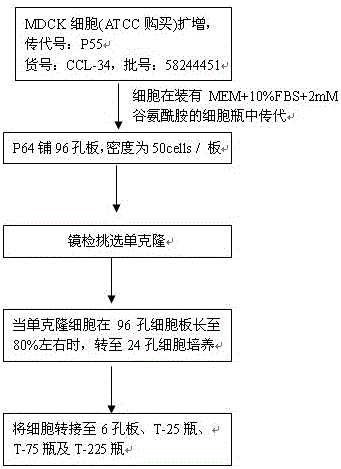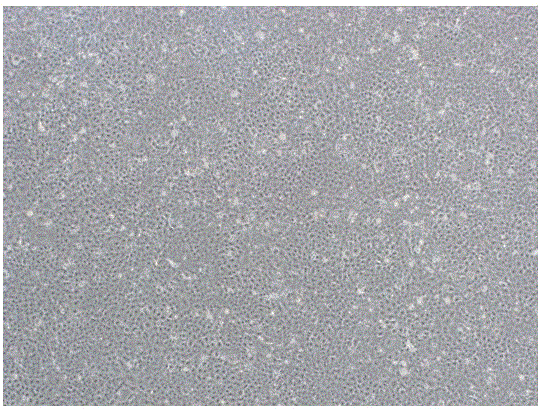Non-tumorigenic mdck cell line and screening method for amplifying influenza virus
An influenza virus, non-tumorigenic technology, applied in microorganism-based methods, animal cells, viruses/phages, etc., can solve the problems of non-tumorigenicity, 1-100 cells may form tumors, etc., and achieve cost savings , the effect of shortening the time
- Summary
- Abstract
- Description
- Claims
- Application Information
AI Technical Summary
Problems solved by technology
Method used
Image
Examples
Embodiment 1
[0051] Embodiment 1, have the acquisition of non-tumorigenic MDCK-2B2 cell line
[0052] 1. Obtaining MDCK monoclonal cells
[0053] 1. Cell digestion and counting
[0054] Passage ATCC CCL-34 MDCK P55 in serum-containing medium (Minimum essential medium + 10% fetal bovine serum (FBS) + 2mM glutamine) for a limited number of passages, MDCK P63 generation cells, select a bottle of T-25 cells for Digestion and counting.
[0055] Take a bottle of MDCK P63 T-25 cells, discard the culture supernatant, wash twice with 1mL trypsin (purchased from Gibco), then add 1mL trypsin, put in CO 2 Incubate in an incubator, observe under the microscope that the cells become round after 15 minutes, add 9 mL of medium to stop digestion, mix the cell suspension, take 10 μL and drop it on a cell counting plate for counting.
[0056] 2. Cell density adjustment and plating
[0057]In order to ensure that there is no single-well polyclonal existence in the 96-well cell plate, reduce the total numb...
Embodiment 2
[0067] Growth morphology and biochemical indicators of embodiment 2, MDCK-2B2 cells
[0068] 1. MDCK-2B2 cells have epithelial-like morphology
[0069] P85 MDCK-2B2 was observed under a microscope (40×), and it was found to be fusiform with regular edges, adherent cells, and epithelial-like morphology.
[0070] 2. MDCK-2B2 has a higher growth density
[0071] Inoculate with the same initial density (2.5×10 5 cells / 5mL) of MDCK-2B2 and MDCK in T-25 cell culture flasks, 7 flasks for each, one of the flasks was extracted at intervals of 24 hours for cell counting, counting continuously for 7 days, MDCK-2B2 cells in 7 days The totals are: 1.8×10 5 cells, 2.9×10 5 cells, 11.6×10 5 cells, 22×10 5 cells, 20×10 5 cells, 20.8×10 5 cells and 10.5×10 5 cells; the total number of cells in MDCK in 7 days were: 2.3×10 5 cells, 4.8×10 5 cells, 19.1×10 5 cells, 21×10 5 cells, 23.5×10 5 cells, 24.87×10 5 cells and 14.5×10 5 cells. Such as image 3 As shown, MDCK-2B2 cells hav...
Embodiment 3
[0076] Embodiment 3, identification of MDCK-2B2 cell chromosome
[0077] 1. Harvest the cells, wash the cell wall twice with 0.85% NaCl solution;
[0078] 2. Digest with 0.25% Trypsin-EDTA for 10-15 minutes. When the cell surface appears wrinkled and changes visible to the naked eye, use a pipette to blow down the cells at 453g (1500rpm / min, eppendorf 5810R) and centrifuge at room temperature for 10 minutes. Remove the supernatant and leave about 0.5 ml;
[0079] 3. Hypotonicity: Add 4-6ml of 0.075M KCl at 37°C, blow with a pipette, and bathe in water at 37°C for 3-5 minutes
[0080] 4. Pre-fixation: add 1.5ml ± (methanol: glacial acetic acid = 3:1) fixative, mix gently in a 37°C water bath for 5 minutes, and centrifuge at 453g (1500rpm / min, eppendorf 5810R) for 10 minutes at room temperature. Remove the supernatant and leave about 0.5ml;
[0081] 5. Fixation: Add 8ml± of fixative, mix gently, bathe in 37℃ water for 10 minutes, and centrifuge at room temperature at 453g (15...
PUM
 Login to View More
Login to View More Abstract
Description
Claims
Application Information
 Login to View More
Login to View More - R&D
- Intellectual Property
- Life Sciences
- Materials
- Tech Scout
- Unparalleled Data Quality
- Higher Quality Content
- 60% Fewer Hallucinations
Browse by: Latest US Patents, China's latest patents, Technical Efficacy Thesaurus, Application Domain, Technology Topic, Popular Technical Reports.
© 2025 PatSnap. All rights reserved.Legal|Privacy policy|Modern Slavery Act Transparency Statement|Sitemap|About US| Contact US: help@patsnap.com



